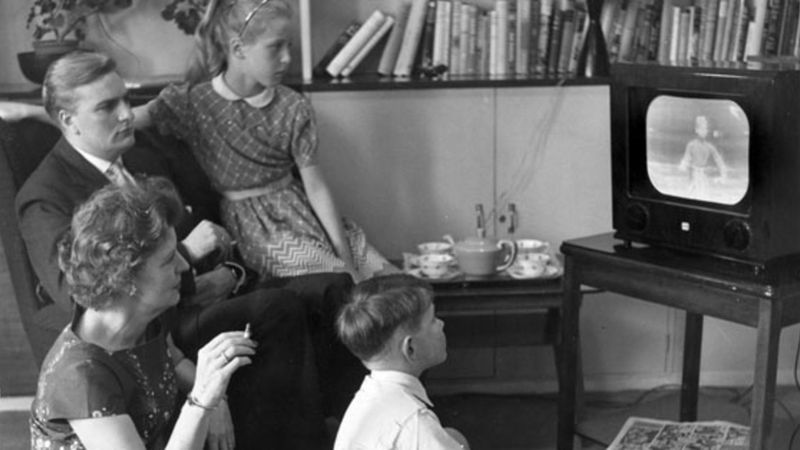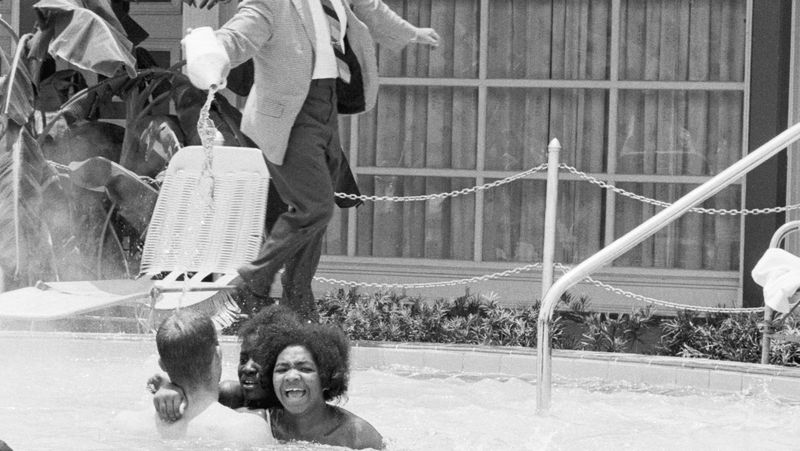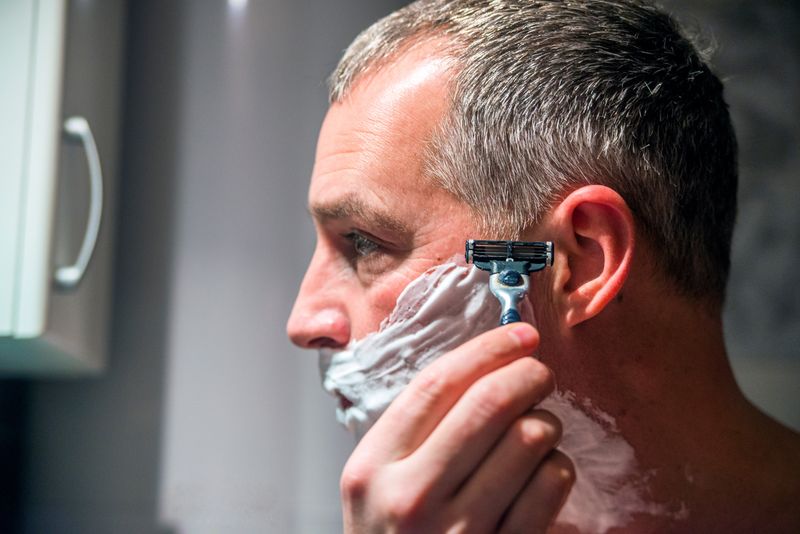16 Things Every ’50s Kid Was Warned About That Ended Up Being Totally Wrong

Growing up in the 1950s was like living in a world powered by rotary phones, milkmen, and well-meaning paranoia.
Our parents, teachers, and that one overly dramatic neighbor were armed with a treasure trove of wildly creative warnings—all delivered with the utmost confidence and zero supporting evidence. Swallow a watermelon seed? Enjoy your new internal garden.
Sit too close to the TV? Say goodbye to your eyesight forever. Cracking your knuckles? Welcome to early-onset arthritis, kid. These cautionary tales were passed down like sacred family recipes—except instead of cookies, they served up fear and confusion.
At the time, we took them as gospel. But now? Thanks to science and a little common sense, we can finally laugh (nervously) at the myths that once ruled our childhoods. So let’s rewind the clock and revisit those well-intentioned whoppers, one hilarious myth at a time. And no, crossing your eyes won’t make them stick. Probably.
1. Swallowing Gum Will Stay in Your Stomach for Seven Years

My cousin Timmy once swallowed five pieces of Dubble Bubble during a baseball game, and Aunt Martha nearly fainted! “That gum will sit in your stomach until you’re in high school!” she shrieked. Every kid in the neighborhood heard similar dire warnings.
The sticky truth? Gum doesn’t hang around nearly that long. While your digestive system can’t break down the gum base, it doesn’t just loiter in your stomach plotting revenge. Your body simply moves it through your digestive tract and out with other waste in a day or two.
Scientists have confirmed this repeatedly, yet somehow this myth continues to bounce around playground wisdom like a rubber ball. Swallowing gum isn’t recommended as a habit, but it won’t form a seven-year collection in your belly!
2. Sitting Too Close to the TV Will Ruin Your Eyes

Saturday mornings meant Howdy Doody time, and I’d scoot as close as possible to our bulky Philco television. Mom would inevitably yank me backward, insisting, “You’ll go blind sitting that close!” It was the universal parental battle cry of the fifties.
Modern science tells a different story. While sitting nose-to-screen might cause temporary eyestrain—that mild discomfort that fades after taking a break—it doesn’t cause permanent damage or vision deterioration. Early TVs did emit some radiation, which sparked the original concern, but even that was minimal.
Today’s ophthalmologists confirm what rebellious kids suspected all along: proximity to screens doesn’t harm vision. The real issue was parents wanting an unobstructed view of Gunsmoke without little heads blocking the screen!
3. Reading in Dim Light Damages Your Vision

Flashlight under the covers, dog-eared copy of Tom Sawyer clutched in my small hands—this nightly ritual always ended the same way. Dad would burst in, confiscate my contraband reading materials, and lecture: “Reading in the dark will make you need glasses!”
Ophthalmologists now roll their eyes at this persistent myth. Reading in low light doesn’t harm vision permanently—it just makes your eyes work harder temporarily. Your eye muscles might get tired from straining, giving you a headache or temporary blurriness, but these symptoms disappear after resting.
The origin of this myth likely stems from the fact that people with existing vision problems tend to bring books closer or seek brighter light. Parents mistook the cause and effect, creating a convenient bedtime enforcement tool that persists despite being completely false!
4. Going Swimming Right After Eating Causes Cramps and Drowning

“Wait at least an hour after eating before swimming!” Mom would holler across the community pool as I fidgeted impatiently, watching my friends splash without me. The dreaded post-hot-dog waiting period seemed like eternal torture under the blazing summer sun.
The reasoning sounded scientific enough—digestion diverts blood from your limbs to your stomach, potentially causing debilitating cramps that would drag you to a watery doom. Dramatic, terrifying, and completely overblown! While competitive swimming on a full stomach might be uncomfortable, casual swimming after eating poses virtually no drowning risk.
No scientific evidence supports the hour-long wait, and the American Red Cross doesn’t include it in water safety guidelines. The myth likely persisted because it gave parents a much-needed break from constant vigilance while kids digested their sandwich-shaped fate.
5. Cracking Your Knuckles Causes Arthritis

Pop! Snap! Crack! Those satisfying sounds earned me countless slaps on the wrist from my grandmother. “Stop that racket or you’ll have arthritis before you’re thirty!” she’d warn, her own gnarled fingers serving as supposed evidence.
Turns out, knuckle-cracking doesn’t lead to arthritis at all. The sound comes from gas bubbles popping in the fluid surrounding your joints—not bones grinding together as we were led to believe. One doctor even cracked knuckles on just one hand for decades to prove it caused no harm.
While excessive knuckle-cracking might occasionally cause some temporary swelling or grip weakness, research has thoroughly debunked the arthritis connection. Those satisfying pops were harmless after all—sorry for all the unnecessary worry, Grandma!
6. Touching Toads Gives You Warts

Jimmy Becker dared me to hold that warty toad we found behind the garage. I nearly did it until Sally Peterson shrieked, “Don’t! The warts will jump onto your hands!” I dropped that poor amphibian like it was radioactive.
Countless childhood adventures were cut short by this widespread fallacy. Toads do have bumpy skin that resembles human warts, but that’s where the similarity ends. Human warts are caused exclusively by human papillomavirus (HPV), which toads neither carry nor transmit. Those bumps on toads are actually glands that secrete substances to deter predators.
While I wouldn’t recommend excessive toad-handling (they can secrete irritating substances when stressed), you absolutely cannot catch warts from them. This misconception robbed many ’50s kids of valuable wildlife appreciation opportunities and unfairly vilified these helpful garden companions.
7. Sugar Makes Children Hyperactive

Birthday parties in the ’50s came with stern warnings: “Don’t let him have too much cake or he’ll be bouncing off the walls!” My mother would eye the punch bowl like it contained liquid dynamite, convinced that sugar would transform me into a miniature tornado.
Multiple scientific studies have thoroughly debunked this connection. Researchers have given children sugar-laden treats or placebos without telling parents which their kids received. The results? Parents who thought their children had consumed sugar reported hyperactivity—even when their children had actually received the sugar-free option!
The real culprit behind birthday party chaos? Excitement, freedom from routine, and being surrounded by other energetic children. While excessive sugar isn’t healthy for other reasons, it doesn’t cause the behavioral changes we were warned about. The sugar-hyperactivity myth was simply a convenient explanation for normal childhood enthusiasm.
8. Crossing Your Eyes Will Make Them Stay That Way

“Stop that this instant, young man! Your face will freeze like that!” Mrs. Abernathy’s warning echoed across the playground as I perfected my crossed-eye monster face to make Sally giggle. This dire prediction was repeated by every adult with alarming consistency.
The human eye is controlled by six muscles that respond to brain signals. While you can voluntarily cross your eyes, they return to normal position when you stop the effort—there’s no mechanism to make them “stick.” Some people have a medical condition called strabismus that causes misalignment, but it’s not caused by eye-crossing antics.
This myth likely persisted because it effectively stopped a behavior adults found annoying or impolite. It’s similar to warnings about face-making during wind changes—convenient parental fiction that helped maintain decorum while having absolutely no basis in physiological reality!
9. Carrots Give You Superhuman Night Vision

“Eat your carrots, Johnny—they’ll help you see in the dark!” Mom would insist, sliding another orange disk onto my plate. This vegetable propaganda was everywhere in the ’50s, and I genuinely believed fighter pilots munched carrots before night missions.
The truth has more to do with wartime deception than nutrition. During WWII, British intelligence spread rumors that their fighter pilots’ exceptional night vision came from eating carrots, concealing their actual advantage: newly developed radar technology. The propaganda campaign was so successful that civilians started growing and eating more carrots, believing they’d help during blackouts.
While carrots do contain beta-carotene, which converts to vitamin A (important for general eye health), they don’t enhance night vision beyond normal levels. The connection between carrots and extraordinary vision was essentially a successful military misinformation campaign that fooled generations!
10. Swallowed Watermelon Seeds Grow Into Plants In Your Stomach

My first watermelon-eating contest ended abruptly when Billy Thompson leaned over and whispered, “Better not swallow any seeds or you’ll grow a watermelon in your belly!” I spat out seeds like machine-gun fire for the rest of summer, terrified of becoming a human garden.
This childhood terror has absolutely no botanical basis. Seeds need specific conditions to germinate—soil, water, sunlight, and appropriate temperatures. Your stomach provides none of these, instead offering a harsh acid bath that breaks down most organic matter. Any swallowed seeds simply pass through your digestive system unscathed.
The myth likely served as a convenient way to prevent children from choking on seeds or making messes. Parents probably never anticipated the vivid mental images of stomach-vines their warnings would create in impressionable minds. To this day, I still catch myself hesitating before swallowing an occasional grape seed!
11. The Great Wall of China Is the Only Man-Made Structure Visible from Space

“Study hard and maybe you’ll build something as impressive as the Great Wall—the only thing humans made that astronauts can see from space!” Mr. Peterson’s geography lesson filled us with wonder about this architectural marvel. The claim was repeated in textbooks, encyclopedias, and by every know-it-all kid on the block.
When astronauts actually reached space in the 1960s, they reported disappointing news—they couldn’t see the Great Wall with the naked eye at all! From low Earth orbit, astronauts can actually see highways, airports, dam reservoirs, and cities much more clearly than the Wall.
The myth began before human spaceflight was possible and persisted because it made for an impressive factoid. While the Wall remains an incredible achievement spanning approximately 13,000 miles, its width is simply too narrow to stand out from orbit without magnification. Sometimes the most persistent “facts” are the ones that sound the most impressive!
12. We Only Use 10% of Our Brains

“Imagine what you could accomplish if you used more than 10% of your brain!” Coach Miller’s pep talks before math tests always included this nugget of pseudo-wisdom. The idea that we had vast untapped mental reserves waiting to be activated was endlessly fascinating to us impressionable students.
Neurologists now laugh at this persistent misconception. Modern brain imaging shows activity throughout the entire brain, with different regions lighting up depending on what we’re doing. No part sits perpetually dormant, waiting for some magical unlocking. While we may not use all our brain simultaneously, we definitely use all parts over time.
This myth likely gained traction because it’s appealingly optimistic—suggesting we all have hidden genius just waiting to be accessed. It’s been used to promote everything from questionable self-help programs to science fiction premises, despite having absolutely no basis in neuroscience. Our brains are already working at full capacity!
13. Listening to Rock and Roll Music Corrupts Youth

The first time I brought home a Bill Haley record, Dad nearly had a conniption! “That music will rot your brain and turn you into a juvenile delinquent!” he thundered, as if those guitar licks contained coded criminal instructions. Parents across America shared this moral panic about rock and roll.
Religious leaders, politicians, and concerned parents genuinely believed this new music would destroy traditional values and increase promiscuity, drug use, and rebellion. Some communities even held record-burning events! The fear was so intense that Elvis was initially filmed only from the waist up on The Ed Sullivan Show.
Decades later, those supposedly corrupted teens became productive, normal adults, and many of today’s grandparents still groove to Chuck Berry. No scientific evidence ever linked rock music to moral degradation or criminal behavior. The real issue was likely generational discomfort with cultural change—something that repeats with each new musical revolution!
14. Comic Books Cause Juvenile Delinquency

My secret stash of Superman comics lived under a loose floorboard in my bedroom—not because I was embarrassed, but because Mrs. Wilson from next door had convinced Mom they were “turning good boys into criminals.” Comic book paranoia reached fever pitch in the ’50s!
This fear was largely fueled by psychiatrist Fredric Wertham’s book “Seduction of the Innocent,” which claimed comics promoted violence, disrespect for authority, and even homosexuality. His work led to Congressional hearings and the creation of the Comics Code Authority, essentially censoring comic content for decades.
Later analysis revealed Wertham had manipulated his research data and drawn unsupported conclusions. No credible evidence ever connected comic reading with increased delinquency rates. Instead, the moral panic primarily reflected adult anxieties about changing youth culture and post-war social shifts. Those “dangerous” comics are now studied as important cultural artifacts!
15. Women Shouldn’t Exercise Because It Would Damage Their Reproductive Organs

“Girls shouldn’t run—it’s unladylike and might shake your insides loose!” Coach Miller would blow his whistle, sending boys to the track while girls were directed to sedate calisthenics. My sister fumed about these different standards but was told it was “for her own good.”
Medical professionals genuinely warned that vigorous exercise could damage female reproductive organs or cause the uterus to “fall out.” Women were cautioned that running might make them infertile or cause their uteruses to dislodge. Physical education for girls focused on gentle movements that maintained “feminine grace” rather than building strength or endurance.
Modern medicine has thoroughly debunked these notions. Not only is exercise safe for women, but it’s beneficial for reproductive health. These misguided warnings reflected both ignorance about female anatomy and social desires to maintain gender differences. Just imagine how many potential female athletes were discouraged by this nonsense!
16. Shaving Makes Hair Grow Back Thicker and Darker

“Don’t start shaving yet, son—it’ll grow back like steel wool!” Dad warned as I contemplated my first three facial hairs. This grooming advice was treated as gospel, with older boys dramatically lamenting their “mistake” of starting to shave too early.
Dermatologists unanimously confirm this is pure fiction. Hair width, color, and growth rate are determined by genetics and hormones, not by whether you’ve taken a razor to it. The illusion occurs because unshaved hair has a natural taper, while shaved hair has a blunt tip that feels coarser and appears darker against the skin.
Similar myths extend to women’s body hair, with warnings about shaving legs creating a “masculine” hair pattern. These misconceptions probably persisted because they seemed to match observation and provided a convenient way to discourage young people from adopting adult grooming habits before parents deemed them ready. Science, however, has thoroughly debunked the shaving-stimulation connection!
